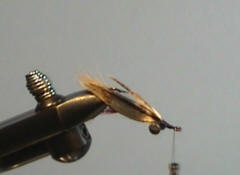|
Flies for All Fish
|
|
![]()
Volume 7, Issue 4
April 2006
The Modern Thief
Fly and Text by Joe Cornwall
Videography and Production by Jim Stuard
More than seventy years ago, Don Gapen created one of the most recognized and effective fly patterns in existence. The Muddler Minnow was designed as an imitation of a sculpin minnow to fool the large, carnivorous brook trout of the Nipigon River. It was, of course, immediately successful.
As the years went by the Muddler Minnow was found to have a similar effect on brown trout, rainbow trout, and, especially, smallmouth bass. An interesting bit of fishing trivia is that Jesse Gapen, Don Gapen’s father, planted some of the first smallmouth bass in Minnesota’s shield lakes. Along the way the Muddler Minnow gained marabou wings, mylar tube bodies and multiple colors. Always it kept the spun deer-hair head and flattened deer hair collar, however. And that was a problem. Deer hair floats; sculpins do not. And spun deer hair can be challenging for a lot of tiers.
Years later the Gapen family would again manage to create a classic pattern, this time it was Don’s son, Dan. The pattern was called the Thief, no doubt because its inspiration was blatantly stolen from the Muddler Minnow! What changed was the substitution of a chenille head for the buoyant spun deer hair of the original fly, a change to a silver body to add a bit more flash, and the addition of a red hackle fiber tail. All told, the changes made for an easier tie and lost none of the effectiveness of the original Muddler Minnow. The Thief is still used, but it never gained the popularity or legendary status of its older sibling. Much is the shame. It’s a great pattern.
The Thief isn’t perfect, though. First, it rides hook-point down,
which can generate a lot of frustration if you’re
fishing a rocky creek or wooded oxbow. If the Thief is weighted with
wraps of lead wire, it tends to sink bend-first. This is a bit
unnatural. In short, the Thief is a good fly, even if it’s not
ultimately refined. Enter the Modern Thief.
The Modern Thief is my take on a great fly. I’ve added the attributes of another classic pattern, the Clouser Deep Minnow, making this Modern Thief inverted and snag resistant. Also, the lead eyes make for a nicely flattened head with a good strong lateral development.
Hook – Daiichi 1750 or any 4xl ring eye hook, size 2 to 10 (size 6 shown).
Thread – Black 6/0 (140 denier).
Tail – Red or claret hackle fibers.
Body – Medium flat silver tinsel or holographic tinsel (shown).
Wing – Red fox squirrel tail or gray squirrel tail flanked by
mottled turkey strips.
Weight – Small or medium lead dumbbell eyes
Head – Black chenille
![]() click here for streaming video
click here for streaming video
You will need Real Player installed on your computer. You can download it from http://real.com
TYING STEPS click on pictures for larger view
|
1. Mount the hook in the vise and start your thread at about the half way point on the hook. Here I’m using a size 6 Daiichi 1750. You can use any 4xl nymph hook. |
|
|
2. Wrap the thread back to a point directly over the hook barb. This is where we will tie in the tail. Select a bit of red or claret strung hackle fibers to make a rolled fiber tail that is about as long as the gape of the hook. |
|
|
3. Tie in a tail of rolled hackle fibers, being careful to ensure that you leave a smooth underbody for the tinsel. Bring the thread back to the tie-in point. Tie in a strip of medium flat silver tinsel or silver holographic tinsel. |
|
|
4. Wrap a smooth tinsel body to the tail and back to the tie-in point again. You want a smooth, two-layer body that has nice flash and finish. Tie off the tinsel. |
|
|
5. Tie in the dumbbell eyes at a point about half-way between the tinsel body and the hook eye. Use figure 8 wraps to hold the eyes securely. Invert the hook in the vice.
|
|
|
6. Tie in the squirrel wing. Red Fox Squirrel is a very good choice, but you can use Pine Squirrel, Russian Squirrel or Gray Squirrel depending on the local baitfish you want to imitate. Tie in a very sparse squirrel tail wing.
|
|
|
7. Select a matching pair of turkey wing feathers to make the over-wing. Cut sections about one-half inch or a little less for a size 6 fly. Cut one section from each feather so they match in curve and color |
|
|
8. Tie in matched wing sections so they veil the squirrel tail underwing. This fly should have an opaque wing in order to effectively imitate a darter or sculpin. |
|
|
9. Select a section of medium black chenille and tie in in front of wing assembly. |
|
|
10. Wrap a fat chenille head. Tie off chenille and whip finish the thread. |
Till next time, tight lines and soft water…

